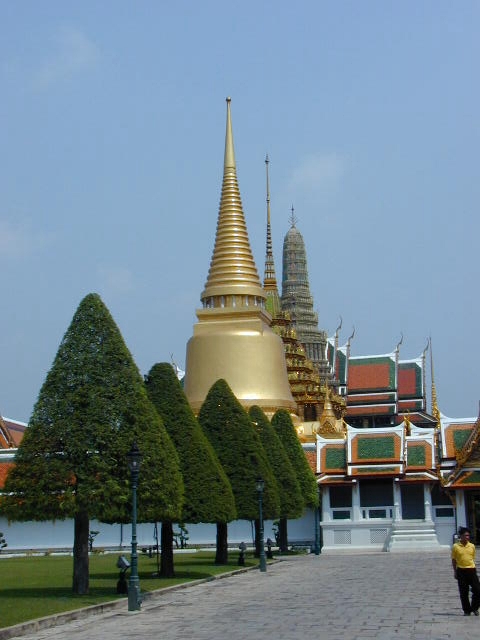zurück
Bangkok :

WAt Phra Keo BKk Bangkok Wat Phra Kaeo (thailändisch วัดพระแก้ว), wörtl.:
Tempel des Smaragd-Buddha,
The
Smaragd-Buddha, or Emerald Buddha,
is one of Thailand’s most revered and sacred religious icons. It is housed in
the Temple of the Emerald Buddha
(Wat Phra Kaew) at the
Grand Palace in
Bangkok, and it holds a
significant place in both Thai Buddhism and national identity.
1.
What is the Emerald Buddha?
- The
Emerald Buddha (known in
Thai as Phra Phuttha Maha Mani
Rattana Patimakorn) is a small, yet highly revered statue of the
Buddha. It is made from
jade or
green marble, not actually
emerald, despite its name. The statue is considered the spiritual heart of
Thailand and symbolizes the protection and well-being of the country.
2.
History of the Emerald Buddha
-
Origins: The exact origins
of the Emerald Buddha are somewhat mysterious, and its history is tied to
both legend and
fact. It is believed to
have been created in India
around the 15th century and
was later brought to Southeast Asia.
The statue was first discovered in
Chiang Rai in northern Thailand in
1434. According to
legend, it was discovered hidden in a
stupa (a type of Buddhist
structure), and the statue's jade-like appearance led it to be called the
Emerald Buddha.
-
Relocation: The Emerald
Buddha has traveled extensively throughout Southeast Asia, having been moved
through Laos,
Burma, and
Cambodia. In
1784, it was brought to
Bangkok by
King Rama I, who
installed it in the newly constructed
Temple of the Emerald Buddha
at the Grand Palace.
Since then, it has remained in Bangkok.
3.
Significance of the Emerald Buddha
-
Symbol of Thai Kingship:
The Emerald Buddha is considered the protector of the Thai nation, and it
holds immense cultural, religious, and royal significance. The Thai king
performs a special ceremony each year to change the robe of the Emerald
Buddha, symbolizing the change of seasons and the role of the king in
protecting the country.
-
Spiritual Importance: For
Buddhists, the Emerald Buddha represents the enlightened nature of
Buddha and the teachings
of Dhamma (Buddhist law).
It is a powerful symbol of peace,
wisdom, and
compassion.
4.
The Temple of the Emerald Buddha (Wat
Phra Kaew)
-
Location: The Emerald
Buddha is housed in Wat Phra Kaew,
located within the Grand Palace
complex in Bangkok.
-
Architecture: The temple
is a masterpiece of Thai religious architecture. The temple’s intricate
design, colorful mosaics, and golden spires are all meant to honor the
Emerald Buddha. The sanctuary
where the Emerald Buddha is kept is highly decorated with murals depicting
Buddhist cosmology and
Thai legends.
5.
Changing of the Robes Ceremony
- The
changing of the robes is
a highly significant royal ceremony that takes place three times a year to
mark the changing of the seasons:
-
Hot season (April – July):
The Emerald Buddha is dressed in gold robes.
-
Rainy season (July – October):
The Emerald Buddha is dressed in a greenish robe.
-
Cool season (October – April):
The statue is dressed in a royal, golden robe.
The king performs this ceremonial ritual as
part of his role as the protector of the country and the guardian of Buddhism.
6.
Physical Description of the Emerald
Buddha
-
Size: The Emerald Buddha
is a small statue, measuring only about
66 centimeters (26 inches)
in height, making it easy to fit into the temple's beautifully ornate altar.
-
Material: Though it’s
called the Emerald Buddha,
it is made from green jade
or marble, and not from
actual emeralds, as the name suggests. The color and the statue’s smooth
surface give it a mysterious and awe-inspiring appearance.
-
Pose: The Buddha is
seated in the meditative posture
(the Dhyana Mudra), with
his hands resting on his lap. The statue's serene expression and the
peaceful demeanor add to its significance as a symbol of
inner peace and
enlightenment.
 26.07.25 Copyright Dirk
Rauschenbach Koelnerstrasse 293 51702 Bergneustadt
Datenschutzerklaerung 02261 9788972 Mail ccooly(
at) web.de
26.07.25 Copyright Dirk
Rauschenbach Koelnerstrasse 293 51702 Bergneustadt
Datenschutzerklaerung 02261 9788972 Mail ccooly(
at) web.de
 Safaris
Bergsteigen
Wandern
Inselwandern Weltweit
Safaris
Bergsteigen
Wandern
Inselwandern Weltweit
 Europa
Inselwandern
Europa
Inselwandern
 Städtewandern
Städtewandern
 Paintings
Paintings Dirk Rauschenbach
Dirk Rauschenbach
 Safaris
Bergsteigen
Wandern
Inselwandern Weltweit
Safaris
Bergsteigen
Wandern
Inselwandern Weltweit
 Europa
Inselwandern
Europa
Inselwandern
 Städtewandern
Städtewandern
 Paintings
Paintings Dirk Rauschenbach
Dirk Rauschenbach

![]() 26.07.25 Copyright Dirk
Rauschenbach Koelnerstrasse 293 51702 Bergneustadt
Datenschutzerklaerung 02261 9788972 Mail ccooly(
at) web.de
26.07.25 Copyright Dirk
Rauschenbach Koelnerstrasse 293 51702 Bergneustadt
Datenschutzerklaerung 02261 9788972 Mail ccooly(
at) web.de